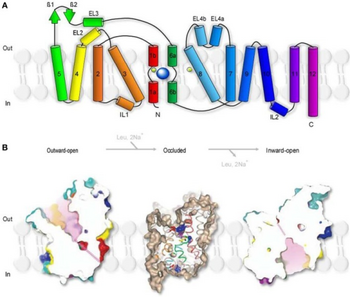GABA transporters (Gamma-Aminobutyric acid transporters) belong to the family of neurotransmitters known as sodium symporters,[1] also known as solute carrier 6 (SLC6).[2] These are large family of neurotransmitter which are Na+ concentration dependent. They are found in various regions of the brain in different cell types, such as neurons and astrocytes.
These transporters are primarily responsible for the regulation of extracellular GABA concentration during basal and synaptic activity. They are responsible for creating a GABA gradient which is determined by the membrane potential, and the concentration of Na+ and Cl−. They are also present on the plasma membrane of neurons and glia which help define their function of regulation of GABA concentration as they act as the receptors that facilitate recycling of GABA in the extracellular space.[1] GABA transporters are a common target for anticonvulsant drugs against seizure disorders such as epilepsy.[3]
Types[edit]

The GABA transporter group consists of six different transporters:
- GABA transporter type 1 (GAT1; SLC6A1)
- GABA transporter type 2 (GAT2; SLC6A13)
- GABA transporter type 3 (GAT3; SLC6A11)
- Betaine transporter (BGT1; SLC6A12)
- Creatinine transporter 1 (CT1; SLC6A8)
- Taurine transporter (TauT; SLC6A6)
GAT1 and GAT3 are the major GABA transporters in the brain and spinal cord, expressed by both neurons and some astrocytes.[4] GAT2 and BGT1 are also expressed in the brain, but at low levels and mostly in the meninges. GAT2 also transports taurine, while BGT1 transports betaine. These two transporters are predominantly expressed in the liver, but are also found in the kidneys and, as mentioned above, in the meninges.[4]
Function[edit]

GABA transporters in the plasma membrane help in regulating the concentration of GABA in the extracellular matrix by reabsorbing the transmitter and clearing the synapse. They transiently bind to GABA in the extracellular matrix and translocate the transmitter in the cytoplasm. The GABA transmitters are not broken down but are cleared via GABA transporters through re-absorption from the synaptic cleft.[1] There is only a 20% loss of the transmitters during each re-absorption while nearly 80% is recycled.[2] The plasma membrane GABA transporters maintain an extracellular GABA concentration in the vicinity of the synapse to control the activity of the GABA receptors. The GABAergic synaptic transmission controls the generation of membrane potential rhythmic changes as the transporters are dependent on Na+ and Cl− ions moving in and out of the across the membrane which are determinants of membrane potential. These changes rely on the precise timing of GABA receptors activation which in turn are dependent upon the release and clearance of GABA in the extracellular space. This reuptake of neurotransmitters plays a significant role in the overall process of synaptic transmission. The GABA transporter is an active system, electrogenic, a voltage-dependent which relies on the inward electrochemical gradient of Na+ ions instead of ATP.[5] It also has low micromolecular affinity to GABA with a Michaelis-Menten constant of 2.5 μM,[1] and requires the presence of Cl- ions in the extracellular matrix. The GABA transporter help creates an equilibrium of GABA and will work in the reverse direction if needed to maintain the baseline concentration of GABA in the system.[1]
Structure[edit]
The structure of Sl6 family transporters share 20-25% sequence similarity with LeuTA[6] providing an evolutionary relationship between the transporter and the leucine transporter protein.[2] Because of the similarity, the LeuTa protein provides a very close template model for the studying the transporters in greater detail.[1] The GABA transporter exists in two different conformations. The transporters have general structure of 12 alpha helices with both end - N Terminus and C-terminus in the cytoplasm with glycosylation sequence in the transmembrane helices.[7] They also exhibit ligand gated ion channel properties as well as substrate dependent properties of leak current. The amino acid sequence ranges from 599 (GAT1) to 700 for glycine transporters.[5]
Role in epilepsy[edit]

GABA creates an inhibitory tone in the cerebral cortex to counterbalance the neuronal excitability.[3] An imbalance between the excitability and inhibition often lead to seizures. To help with epilepsy disorder, anticonvulsant drugs are designed which specifically attack the GABA system. These drugs often attack the transporters blocking their activity, which affects the neuronal excitability. Anticonvulsants such as Tiagabine attack the GABA transporters inhibiting the uptake of GABA neurotransmitter. In patients with temporal lobe seizures, there is a decrease in GABA release because of the impairment of transporters. Drugs such as Vigabatrin cause reversals in GABA transporters that increase the concentration of GABA in the synapse which helps in inhibiting the neuronal excitability.[3]
References[edit]
- ^ a b c d e f Scimemi A (2014-06-17). "Structure, function, and plasticity of GABA transporters". Frontiers in Cellular Neuroscience. 8: 161. doi:10.3389/fncel.2014.00161. PMC 4060055. PMID 24987330.
- ^ a b c Bernstein EM, Quick MW (January 1999). "Regulation of gamma-aminobutyric acid (GABA) transporters by extracellular GABA". The Journal of Biological Chemistry. 274 (2): 889–95. doi:10.1074/jbc.274.2.889. PMID 9873028.
- ^ a b c Richerson GB, Wu Y (2004). "Role of the GABA Transporter in Epilepsy". Recent Advances in Epilepsy Research. Advances in Experimental Medicine and Biology. Vol. 548. Springer US. pp. 76–91. doi:10.1007/978-1-4757-6376-8_6. ISBN 9781441934185. PMID 15250587.
- ^ a b Zhou Y, Danbolt NC (2013-11-11). "GABA and Glutamate Transporters in Brain". Frontiers in Endocrinology. 4: 165. doi:10.3389/fendo.2013.00165. PMC 3822327. PMID 24273530.
- ^ a b Ed., Egebjerg, Jan, Ed. Schousboe, Arne, Ed. Krogsgaard-Larsen, Povl (2002). Glutamate and GABA receptors and transporters : structure, function and pharmacology. Taylor & Francis. ISBN 978-0748408818. OCLC 981443324.
{{cite book}}: CS1 maint: multiple names: authors list (link) - ^ Kristensen AS, Andersen J, Jørgensen TN, Sørensen L, Eriksen J, Loland CJ, Strømgaard K, Gether U (September 2011). "SLC6 neurotransmitter transporters: structure, function, and regulation". Pharmacological Reviews. 63 (3): 585–640. doi:10.1124/pr.108.000869. PMID 21752877. S2CID 2555003.
- ^ Gadea A, López-Colomé AM (March 2001). "Glial transporters for glutamate, glycine, and GABA: II. GABA transporters". Journal of Neuroscience Research. 63 (6): 461–8. doi:10.1002/jnr.1040. PMID 11241581.